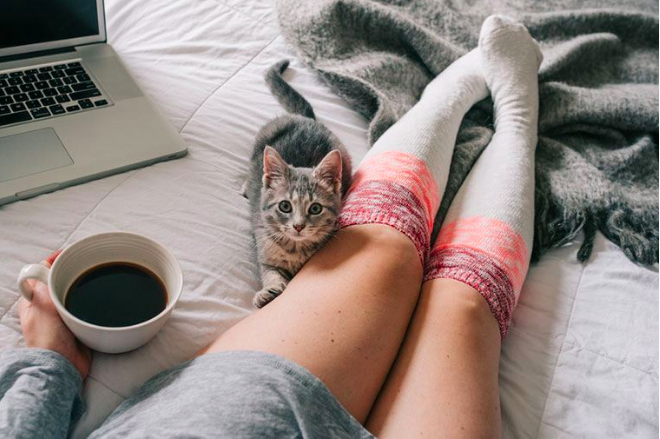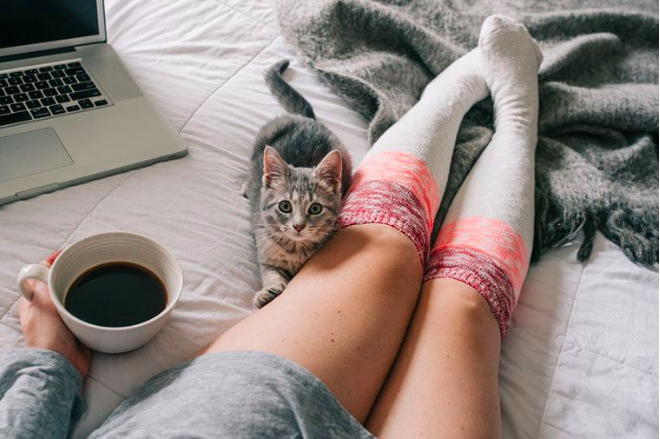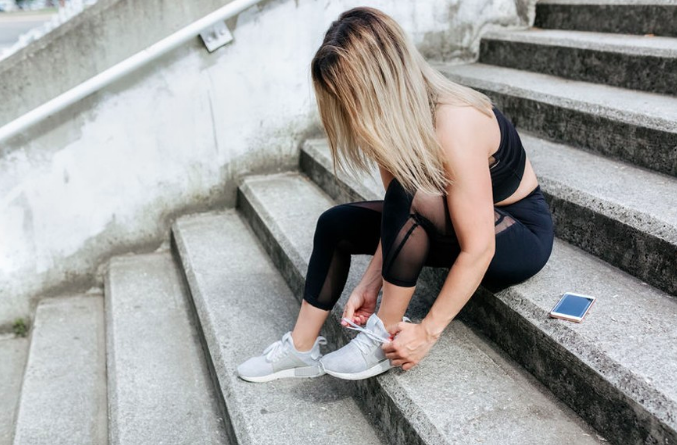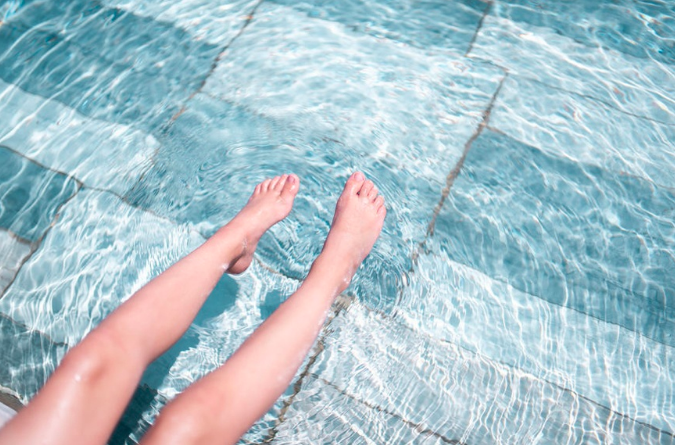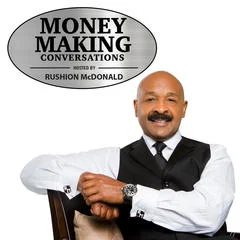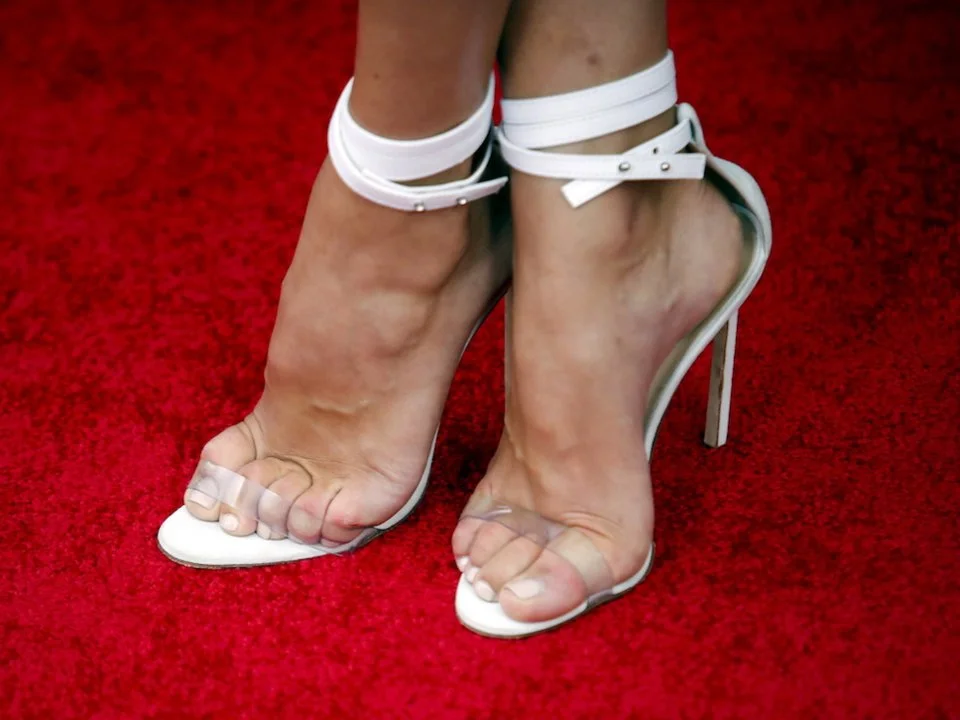Well+Good Wants to Know About Socks -- Dr. Ragland Talks About Fabric for Your Feet
It’s nearly that magical time of the year where feet start sweating and sloshing in the snow, and a little bit of neglect could lead to serious problems. And when it comes to a personal question like—how often should you change socks—during the throes of winter, it isn’t automatically obvious to everyone. So, just how often should you change socks? Well+Good’s Mary Grace Garis consulted with Dr. Ragland, who lit the path forward on how to care for your feet, and specifically how often to change out of socks. Here’s the intel!
“ON A SCALE OF 1 TO 10, HOW GROSS IS IT IF I NEVER CHANGE MY SOCKS?”
Written by MARY GRACE GARIS for Well+Good
It’s nearly that magical time of the year where feet start sweating and sloshing in the snow, and a little bit of neglect could lead to serious problems. Although you try to be as hygienic as possible when it comes to changing out of gym clothes post-workout, it’s easier to neglect day-to-day foot care. And when it comes to a personal question like—how often should you change socks—during the throes of winter, it isn’t automatically obvious to everyone. By “everyone,” I mean me specifically.
So, just how often should you change socks? “That’s easy, every day,” my roommate Emily posited during dinner. “Wait, really,” I asked, my brows furrowing. “Every day?” “Yes, every day,” Emily said, weirded out. “Do you not change them every day?” “Uh, no, I literally wear whatever the hell I can find in my room, half the time my socks don’t even match,” I said.
Now granted, I mainly wear dresses and tights, so while I am undeniably gross, I’m also a little less gross than that sounds. But determined to find out where on a 1-to-10 scale I fell, I consulted a podiatrist, who lit the path forward on how to care for your feet, and specifically how often to change out of socks. Here’s the intel.
Photo: Stocksy/Melanie DeFazio
If you’re battling Athlete’s Foot, change your socks frequently
One thing became certain from Yolanda Ragland, DPM, a New York City-based podiatrist and foot surgeon and founder of FixYourFeet.com from the get-go. If you have Athlete’s Foot, you can’t be so nonchalant about sock changes. Yes, that between-the-toes cracking and dryness so often associated with the locker room, occurs no-matter your activity level, due to a charming fungi that affects the top layer of the skin through small cracks or wounds. Anywhere between 15 to 25 percent of the population suffer from it at any given time.
“If you suffer from fungal infection of the foot, chances are you also suffer from sweaty feet,” she says. “Changing your socks twice daily is recommended. However, simply changing your socks will not prevent Athlete’s Foot because the fungal organism is extremely hardy.” So, you should also wash them with every sock change, and once they’re dry, use an anti-fungal cream to keep even more microbes from showing up to the party.
If you’re not dealing with Athlete’s Foot, there’s still a solid rule that you should change your socks everyday (sorry! sorry!) to keep bacteria and, yes, fungus from greeting you, too.
It may seem cozy, but don’t layer socks
You know how when the temperatures drop to bitter levels, you decide to layer pairs over pairs of socks in the effort to fight frostbite? Yeah, you want to not. “In the winter months, the feet get cold quickly because, after all, they are the part of the body that is closest to the ground!” says Dr. Ragland. “Layering socks might sound intuitive, but keeping the foot too warm will trigger sweating and bacteria, especially since fungus thrives in warm, dark, moisture conditions. Unless you are in subzero weather, there is no need to layer socks—they will only encourage microorganisms to propagate and could result in itchy malodorous feet.” Oh my God, I haven’t even been wearing my gross socks correctly.
Pick a fabric that’s kind to your feet
So now that layering socks on socks is out of the question, what is the warmest, cleanliest material? Despite the fact that everyone always kvells over cotton (the fabric of our lives and all that jazz), it doesn’t wick moisture as well as a synthetic.
“Think about it—all of your workout apparel is made out of synthetic materials, not cotton,” she says, because synthetics tend to absorb moisture quicker and return to regularly scheduled dry programming. “The same goes for socks. Look for thermal socks specializing in soaking up the sweat and keeping feet dry.”
So regardless of the situation you’re in, I wonder if there’s one type of sock that reigns supreme for foot cleanliness. Ultimately, “wearing a sock specializing in wicking and absorption is your best option,” said Dr. Ragland. “Merino Wool socks are great—this [is] natural fiber, which means it is breathable and can mechanically transport moisture and vapor from a higher area of humidity by the skin to a lower area of humidity away from the skin.
READ THE FULL STORY AT WELL+GOOD. BIG THANK YOU TO WRITER MARY GRACE GARIS, AND EDITOR ALI FINNEY FOR INTERVIEWING DR. RAGLAND.
ALLURE Interviews Dr. Ragland About the Best Insoles for Walking and Running
Insoles, orthopedics, heel lifts, arch cushions — there's a lot of terminologies to sort through when you're shopping for shoe inserts, and it can be pretty confusing if you don't know where to start. To help clarify some of the confusion, Allure.com’s Maria Cassano got in touch with Dr. Yolanda Ragland, a podiatric surgeon and the founder of Fix Your Feet, Inc. "A good pair of insoles can have multiple benefits," Ragland says.
The Best Shoe Insoles for Walking and Running
Insoles, orthopedics, heel lifts, arch cushions — there's a lot of terminologies to sort through when you're shopping for shoe inserts, and it can be pretty confusing if you don't know where to start. On the bright side, when you're trying to make your shoes more comfortable, there's an option out there for every pair and every person. To help clarify some of the confusion, I got in touch with Yolanda Ragland, a podiatric surgeon and the founder of Fix Your Feet, Inc. "A good pair of insoles can have multiple benefits," Ragland says. "Good insoles can provide shock absorption, correct malalignment, reduce fatigue, boost athletic performance, improve comfort, and relieve chronic foot pain like plantar fasciitis." If all of that sounds like a dream but you're not sure how to find the best inserts for you, check out Ragland's advice and recommendations for all different kinds of foot-related issues.
OCTOBER 18, 2018
Image from Allure.com
Powerstep Full-Length Orthotic Shoe Insoles
First thing's first: What is the difference between inserts and orthotics? "All orthotics are inserts, but not all inserts are orthotics," explains Ragland. "An insert is any fabrication that is designed to go into a shoe to improve the shoe’s fit, function, or comfort — for example, heel grippers are inserts that adhere to the back heel part of the shoe, called the counter." Orthotics, on the other hand, are inserts that "lay on the floor of the shoe, called the insole," says Ragland. "Commonly, orthotics are prescribed to maintain arch support, but they can be customized to treat a litany of foot conditions such as metatarsalgia, hyper-pronation, hyper-supination, big-toe stiffness, and neuroma pain, among others."
Footminders Orthotic Dress Shoe Insoles
According to Ragland, you likely won't be able to get one orthotic that's suitable for all your different types of shoes. "An orthotic for a sneaker and a dress shoe for the same person will be fashioned with completely different materials," she explains.
"The material used to produce an orthotic depends on what the orthotic is being designed to remedy," Ragland says. And on the synthetic end, she adds, you have plastics, cushion foams, and silicone gels.
Helloheel Fitter Grips Heel Liners
Heel grippers aim to reduce friction on the back of your heel, says Ragland, like these Helloheel Fitter Grips heel liners. They're made from biodegradable rubber covered in soft suede, and they're a great option if your shoes often slip off or you get blisters at the backs of your ankles.
More natural options are available in the form of leather, cork, or wool, says Ragland. These SoxsolS wool flat insoles provide a thin layer of comfort and are especially useful when it comes to keeping your shoes sanitary. They absorb sweat and odors from flats, moccasins, heels, and other sockless shoes, and when they start to get smelly, you can just toss them in the washing machine and start over fresh.
Natural Foot Orthotics Plantar Fasciitis Inserts
According to Ragland, “Plantar fasciitis is the most common reason why orthotics are dispensed and worn. An orthotic helps to support the arch, establishing relief from plantar-fascial pain.”
Inflexible plastics are not the only option for plantar fasciitis. According to Ragland, “Leather was the original material used for arch support and continues to be used today for people who cannot tolerate a rigid, plastic device.”
Ballotte Ball of Foot Cushions
Yet another problem that could be causing your foot pain: fat-pad atrophy. Ragland says this is "the degeneration of the natural, fatty cushion on the ball of the foot. Inserts for the ball of the foot provide cushioning to relieve fat-pad atrophy." Ballotte Ball of Foot cushions "offer a selection of complete foot gel cushions covered with friction-resistant material," she says, and since they're made from self-adhesive silicone, they're sanitary, shock-absorbing, and easy to apply. These are especially effective for heels, but can also be used on other styles of shoes that agitate the balls of your feet.
If you're not sure if you need insoles but suspect that you might, Ragland offers this advice: "Heel inserts or lifts are often dispensed by podiatrists before casting for custom-made orthotics because, if they relieve some pain, then a custom-fabricated insole will work. Lifts take pressure off the plantar fascia and can alleviate pain associated with plantar fasciitis."
Read the full story on Allure.com by Maria Cassano. Big thank you to Allure and Cassano for interviewing Dr. Ragland on this important topic for women!
"Enjoying Life On Purpose" Podcast's Kimberly Frazier Interviews Dr. Ragland
Business & Life Coach Kimberly Frazier's "Enjoying Life On Purpose" podcast shares tips on how you can begin to enjoy life on purpose no matter the situation. Tune in for topics ranging from the importance of optimism and today’s the glass ceiling to caring for your feet and entrepreneurial advice!
Business & Life Coach Kimberly Frazier's "Enjoying Life On Purpose" podcast shares tips on how you can begin to enjoy life on purpose no matter the situation. She brings everyday people with everyday experiences to the everyday radio!
Today, Frazier interviewed our very own Dr. Yolanda Ragland, and the interview was shared via Vercay Radio broadcast on IHeartRadio, iTunes, Google Play, Amazon and Apple Play:
Tune in to learn about...
Why Dr. Ragland Named Her Practice "Fix Your Feet"
The Importance of Optimism in Everyday Work
Failures vs. "Learning Experiences"
The Glass Ceiling, Yesterday and Today
How to Know if You Need a Fix Your Feet Consult
Foot Relief - How Effective Surgery Can Be
Financial Advice for Fellow Entrepreneurs
Well+Good "Feet Week" Features Dr. Ragland's Advice on "How to Banish *All* the Foot Problems"!
Few things are worse, IMO, than when someone asks you to remove your shoes upon entering their house. Whether your toes are deformed from a childhood spent in pointe shoes or your nails are just in need of a paint job there are, in my mind, few (if any) commonly-exposed body parts so cringe-worthy as those located south of your ankles. Yolanda Ragland, DPM, podiatrist, foot surgeon, and owner of Fix Your Feet, shares intel on some of the most common issues with which patients step into her practice, including remedies so you no longer have to run away when someone asks you to go sans shoes. (Or is that just me?)
Photo: Stocksy/Lyuba Burakova via Well+Good
ERIN BUNCH, AUGUST 3, 2018
Few things are worse, IMO, than when someone asks you to remove your shoes upon entering their house. Whether your toes are deformed from a childhood spent in pointe shoes or your nails are just in need of a paint job there are, in my mind, few (if any) commonly-exposed body parts so cringe-worthy as those located south of your ankles.
All sorts of things can go wrong with your southernmost appendages, especially given their frequent use in a variety of circumstances...Yolanda Ragland, DPM, podiatrist, foot surgeon, and owner of Fix Your Feet, shares intel on some of the most common issues with which patients step into her practice, including remedies so you no longer have to run away when someone asks you to go sans shoes. (Or is that just me?)
Keep reading for everything you need to know in order to put your best foot forward.
Photo: Stocksy/Marco Govel via Well+Good
Athlete’s foot
“There are two types of people when it comes to contracting athlete’s foot,” explains Dr. Ragland. “People who are susceptible to developing the infection, and those who are not.” In other words, if you have been a sufferer of athlete’s Foot in the past, it’s likely the fungus will recur in the future.
For this reason, prevention is key. “Wearing clean, wick-absorbing socks, or footies, helps to discourage fungal growth, says Dr. Ragland. “Using anti-fungal creams, gels, sprays, or powders, daily, will also significantly reduce repeat-infection rate.” ...
Bunions
I don’t know about you, but I actually had no idea what a bunion was until I looked into it for this story. “A bunion is a bony prominence of the big toe joint,” Dr. Ragland explains. “The long bone connected to the base of the toe, called a ‘metatarsal’, is in poor alignment and protrudes outward, forming a bump, while the big toe rotates inwardly pushing up against the second toe.” ... Dr. Ragland also points out that the condition can “ruin” shoes, which is another reason to opt in on surgery. (I’ll say!)
Calluses
Calluses, while ugly and sometimes painful, are actually trying to do a good thing for your foot. “They’re formed as a protective armor for the skin, so it does not break down,” says Dr. Ragland. “Non-painful calluses on a healthy foot do not need any treatment; however, a thick callus can be painful to walk on, much like having a pebble stuck to the skin.”
If yours bugs you, Ragland says you can treat it by removing the top layer of thickened skin. One way in which this is done is likely familiar if you’re a fan of regular pedicures—using a pumice stone or an emery board, you can (slowly and gently) grind down the hardened skin. A second method, which uses a blade-type instrument (e.g. a razor) to cut or shave the affected skin, should only be attempted after consulting a podiatrist. A third utilizes an acid-based agent—generally a urea-based salve or salicylic acid treatment—to slough the tough skin down. This too, should only be tried in consult with your doctor. The final option, says Ragland, is complete excision. “The callus can be fully removed along with the normal, underlying skin and closed with stitches,” she says. “This procedure can be performed in the office by your podiatrist, but is reserved for extreme cases and is rarely recommended because the scar from the excision can be just as painful as the callus.”
In some populations, calluses can lead to more serious conditions than a temporary limp. “Patients that are immunocompromised, like diabetics, are at risk of ulceration in the areas where once the callus could form, but due to a weakened immune system can no longer do so,” says Dr. Ragland. “This skin becomes friable and ulcerates, now increasing risk for infection which could ultimately lead to amputations if not treated immediately.”...
Photo: Stocksy/Lea Csontos via Well+Good
Smelly feet
...Dr. Ragland says that astringents, which cause contraction of the skin, can help to close pores and block sweat glands, thereby eliminating unpleasant scents. “Homeopathic, astringent-based remedies include Hydrofluoricum Acidum, Silicea, and Witch Hazel,” she says. (A foot bath can help, too.)
If this is a chronic issue for you, you may also want to investigate the cause of excessive sweating, advises Dr. Ragland, “Hyperhidrosis [excessive sweating] can be linked to anxiety, excessive coffee drinking, consumption of alcohol, neurological conditions, diseases like diabetes, hormone changes, hyperthyroidism, tumors, infections and even mercury poisoning,” she explains.
With those underlying issues cleared, you should consult your podiatrist about medical intervention if you’ve exhausted the conservative therapies listed above (along with the patience of your loved ones). “While these are more invasive or pharmaceutical, these are longer-lasting and have proven to be extremely effective,” she explains.
Detached toenail
...Most often, toenail loss results from injury, fungal infection, or psoriasis, says Dr. Ragland. “Psoriasis causes changes in the nails which may result in a dry brittle nail causing the nail to left from the nail bed and eventually fall from its attachment to the skin,” she explains. More rarely, chemicals, medications, and serious illness can be contributing factors as well. “Illnesses like cancer that require chemotherapy to attack fast-growing cells can result in toenail disfigurement or loss,” Dr. Ragland says.
Big thank you to Erin Bunch and Well+Good for including Dr. Ragland and Fix Your Feet in "Feet Week"! Read the full story on Well+Good, follow Bunch's stories, and stay up with the latest at Well+Good.
Dr. Ragland for Well+Good - Should You Be Running on the Beach?
Few things beat a summertime beach workout, but if at some point you hear the siren song of the shoreline begging you to run along it, is it okay to leave your sneakers behind and go barefoot? Dr. Ragland is interviewed by Well+Good’s Erin Bunch to advise us on what to do.
By ERIN BUNCH
Photo: Stocksy/Studio Firma via Well+Good
Few things beat a summertime beach workout (just ask Halle Berry), but if at some point you hear the siren song of the shoreline begging you to run along it, is it okay to leave your sneakers behind and go barefoot? ...
New York City-based podiatrist and foot surgeon Yolanda Ragland, DPM, agrees that running barefoot in the sand offers up a more challenging workout—but that added intensity can create problems. “You can wind up spraining your ankle, getting plantar fasciitis, or straining, tearing, or rupturing your Achilles [tendon],” she says, noting that broken shells and other such natural hazards are also a risk. “[Therefore], running with sneakers is best, but you can work up to running without them gradually.”
On the plus side, all barefoot beach runners—experienced or not—can avoid injury by following a few specific guidelines. For starters, Ragland advises running close to the water, where the sand is more stable. She also says to be sure you’ve selected a flat stretch of sand and that your feet are moving on the same plane and not at different angles. (Often, the tide cuts into the beach in a way that creates a slope—you’ll want to run below or above this.)
For newbies, Ragland offers some additional advice: “Always start off running for far less time than you do on normal surfaces or treadmills,” she advises. “Gradually increase your time on the sand by two-to-three-minute intervals per day to acclimate and allow your feet to make muscle accommodations.” ...
Big thank you to the amazing journalist Erin Bunch for including Ragland's perspective. Read the full story and be sure to follow Bunch's stories!
Dr. Ragland's 2nd Appearance on Rushion McDonald iHeartRadio "Money Making Matters"
"I don't believe in telling ANYONE they can't wear the shoes they love wearing," says Dr. Ragland. "I do ask them to wear them within reason... Especially for ladies because we are teetering on heels, I will say walk with a pair of safety shoes.” - Read this blog about Dr. Ragland’s appearance on Rushion McDonald’s “Money Making Matters” on iHeartRadio!
Dr. Yolanda Ragland joined Rushion McDonald on "Money Making Matters" on iHeartRadio again on June 18! Below are excerpts from the interview. Listen to the full podcast episode on iHeartRadio.
"I got bad feet!" exclaimed McDonald. "I have been having bad feet for a long time. God gave me good feet, but I messed them up wearing tight shoes, pointed-toe shoes, shoes that I knew were hurting my feet, but I didn't care! The women loved them! I got complements! 'You look good. You're styling, you're profiling!' My next guest is one of the top foot surgeons in America. She's my best friend, CEO and Founder of Fix Your Feet, Inc. She has 15 years of medical experience and maintains offices in Park Avenue in New York City - I went by there - and in Downtown Silver Springs, Maryland. The focus of her practice is bunions. I got a bunion. The focus is hammertoes. I got a hammertoe!" ...
"I travel a lot, " continued McDonald. "How can I make my feet comfortable? Some days I have good times with my feet. Some days I have bad times with my feet. What can I do on a regular basis to take care of my feet?..."
"I don't believe in telling ANYONE they can't wear the shoes they love wearing," responded Ragland. "I do ask them to wear them within reason... Especially for ladies because we are teetering on heels, I will say walk with a pair of safety shoes. That advice translates right with men too... After you have been donning those shoes for the last two hours, maybe you need to take a break from those for a minute. More importantly, when you are purchasing those shoes, you can still look at those shoes that you like - all of them don't hurt you. I know you have some beautiful shoes that the women are gravitating toward... Find those shoes that work for you!"
"Dr. Ragland, what exactly is Fix Your Feet and why did you start this organization?" asked McDonald.
"First and foremost, the core group is definitely women because we are wearing heels and I understand what ti's like to walk in those shoes. The feet that carry us should support a strong foundation, especially for strong women like myself. I became a podiatrist because I wanted to support women with a strong foundation. As you mentioned before, I am proud to be the only female podiatrist out there that has a practice solely dedicated to correcting bunions and hammertoes with a cosmetic result. I created the Tiara Toe TechniqueTM, which allows me to do the traditional orthopedic procedures...but with an aesthetic outcome..."
Thank you for reading these excerpts! Listen to the full podcast episode on iHeartRadio.
ABOUT MONEY MAKING CONVERSATIONS
Each Money Making Conversations show hosted by Rushion McDonald is about entrepreneurship and entertainment. We provide the consumer and business owner access to Celebrities, CEOs, Entrepreneurs and Industry Decision Makers. They in turn deliver information about career planning, motivation, financial literacy and how they lead a balanced life. Don’t miss Money Making Conversations with host Rushion McDonald streaming LIVE every Monday at 10AM-12PM EST on biz1190 (www.biz1190.com), on our Facebook fanpage, anytime through our iHeartRadio Podcast, which can be found under the Business/Finance Section, Fridays at 10AM ET on SiriusXM Channel 141: H.U.R. Voices and Fridays at 7PM ET on SiriusXM Channel 142: HBCU. We want to keep you Winning with your Career and your Life! #AskMMC The Money Making Conversations radio talk show shares the “Secrets of Success” experienced firsthand by marketing and branding expert Rushion McDonald. Mr. McDonald is a brand guru and has been a marketer for major national and global brands like State Farm, Ford and Home Depot. He has worked with Kevin Hart, Stephen A. Smith, Jamie Foxx and most notably, Steve Harvey and will provide access to women and multicultural markets to expand the reach of your brand. The show features one-on-one career advice to callers, contributions from corporate leaders, successful entrepreneurs, celebrity interviews regarding their business ventures, social media branding, financial planning and information to empower small businesses to a path of success! “The Kind of Talk that Inspires Change.”
Dr. Ragland in Huff Post! "5 Ways To Get Your Routine Summertime Ready"
When it’s nice out, it’s normal to feel an itch to get all your steps in outdoors. Just make sure your feet are prepared for the extra pressure. If you’re regularly going for long summer walks in flip-flops or high-heeled summer sandals, you could be doing your feet a real disservice, said Dr. Yolanda Ragland.
By RYOT Studio
If you live in a locale that has all four seasons, you know the beginning of summer means a serious lifestyle shift. Puffy jackets are retired in favor of tank tops, cozy nights by the fireplace are swapped for beachside bonfires and complaining about the cold is replaced by complaining about the sweltering heat.
While most of these changes happen naturally, there are probably a few cold-weather habits you’re unconsciously keeping up year-round — habits that could put a real damper on your summer fun...
Step up your shoe game
When it’s nice out, it’s normal to feel an itch to get all your steps in outdoors. Just make sure your feet are prepared for the extra pressure. If you’re regularly going for long summer walks in flip-flops or high-heeled summer sandals, you could be doing your feet a real disservice, said Dr. Yolanda Ragland, a podiatrist and founder of Fix Your Feet.
“Flip-flops are better as shower shoes or walking from the car to the beach, and they should be used in light moderation,” said Ragland. “If you wear flip-flops every day, you are more vulnerable to getting plantar fasciitis because they are too flat. Any heel that is too high is not good for you either. For flip-flops or heels, my advice would be to wear in moderation. A high-heeled shoe or sandal, or even a platform sandal, keeps you vulnerable to an ankle sprain due to turning your ankle inward, or rupturing a ligament that surrounds the lateral ankle.”
Big thank you to the fabulous journalist Caroline Thompson for including Dr. Ragland in her story!
Dr. Ragland in SheKnows! Podiatrists Tell Us How to Pick Sandals So Comfortable You Can Wear Them All Day
“What you’re looking for in a sandal, for all-day wear, is a sandal that provides arch support instead of one that is flat,” Dr. Yolanda Ragland, founder of Fix Your Feet, tells SheKnows. “The sandal should have shock absorption, like a rubber- or cork-type sole. The sandal’s bottom should be firm, yet flexible. Look for a sandal that keeps toes in a more stable position, so they are not bending as much, and you can control the toe grip.”
by Elizabeth Yuko
Every year, as soon as the temperatures start rising and the sun comes out, so do the sandals. They're cute and let you skip the step of putting socks on in the morning (bonus: less laundry) and are usually pretty versatile.
But sandals can also be extremely uncomfortable. All those buckles and straps and pieces of fabric — not to mention some very flat footbeds — that can rub you the wrong way means that sometimes, the first time you wear a pair of sandals is also the last time.
Image: Vionic, Dr. Scholl's, SAS Shoes, Okabashi/Design: Ashley Britton/SheKnows
So, to start with, look at the footbed of the sandal and make sure it has some sort of arch support and isn't just a flat piece of plastic. “What you’re looking for in a sandal, for all-day wear, is a sandal that provides arch support instead of one that is flat,” Dr. Yolanda Ragland, founder of Fix Your Feet, tells SheKnows. “The sandal should have shock absorption, like a rubber- or cork-type sole. The sandal’s bottom should be firm, yet flexible. Look for a sandal that keeps toes in a more stable position, so they are not bending as much, and you can control the toe grip.”
Next, look at the straps.
“If you’re looking for a little ankle stability, find a sandal that has a gladiator style,” Ragland explains. “This style of ankle strap comes up around the ankle, offering ankle support and decreasing your chances of rotation of the ankle inwardly, which can cause a lateral ankle sprain.”
... Big thank you to Elizabeth Yuko and SheKnows for shining a light on this important issue for women! Read the full story.
Dr. Ragland Featured in INSIDER: 7 Scary Things That Can Happen When You Wear Heels Too Much
There are a ton of different techniques and tips that you can use to make wearing heels not only more comfortable, but also slightly less harsh on your body. Still, knowing what kinds of things you might be in for can help you prepare ahead of time and quickly react if something goes wrong.
Christian Augustin/Getty Images
Wearing high heels can have long-term effects on your feet.
- Wearing high heels can take a serious toll on your feet.
- Though heels often aren't the most comfortable footwear option you have available to you, there are plenty of times when no other style will do.
- Knowing some of the potential effects you're risking when you wear high heels, especially over longer periods of time, and how to potentially ward off some of those effects can help you take of yourself and your feet.
High heels aren't often considered to be the most comfortable shoes in your closet, but sometimes you need or want to wear them. You're likely intimately familiar with the pain and blisters that can (and often do) come along with wearing high heels, but you might not realize that your shoe choice can have a real effect on you beyond just the temporary pain associated with squeezing your feet into the shoes.
If you're going to wear high heels, you need to know not only what sorts of things your choice of shoes might be causing, but also how to help address those issues.
1. You could injure an ankle or end up with stress fractures.
Even if you only have your shoes on for a minute or two, you could potentially hurt yourself.
"[Y]ou could've just put on the shoe and headed out, literally take one step and step on a pebble, and then turn your foot inward and then either strain or break the ligament structures around what we call the lateral side of the ankle — so the outer part of the ankle — and it's called a lateral ankle sprain," Dr. Yolanda Ragland, a podiatrist and the founder of Fix Your Feet, told INSIDER.
You don't have to spend a long time in your heels in order to feel the effects. Though this type of injury probably isn't the very worst thing in the world, it's undoubtedly painful and healing takes time (and sometimes some effort). An injury like this one is a potential for anyone who wears high heels for even a minute or two, but can be especially risky for people who wear heels only seldomly...
Practicing walking in heels — and learning how to do it — might not sound as silly know as it may have before.
2. Arthritis is a real concern.
Wearing heels too often can lead to arthritis.
Ragland said that the joints in your knees or further down into your foot can become arthritic if you wear heels too much because the way that you're compensating while standing or walking can cause the cartilage in these joints to wear down. That's something that you might not consider all that often when determining what sort of shoes to wear or how often to wear high heels, but it's something to keep in mind.
3. You could make existing foot problems worse.
If you already have things like hammer toes, ingrown toenails, corns, bunions, and more, you might notice that wearing high heels can make those things worse.
"[I]f you have bunions or hammer toes, wearing high heels can exacerbate those problems," Ragland said. She added that bunions can grow and become painful more quickly when you're wearing heels versus if you're primarily sticking to flats.
Fabrizio Bensch/Reuters
Wearing high heels can put you at a greater risk of injuring yourself even when you're not wearing them.
Not only that, but you also might notice a bump form (or become a bit worse) on your heels.
"[Y]ou can get a bump that forms because the shoe is rubbing on the back of the heel, which is the calcaneus, and your Achilles tendon inserts into that area, so what happens is that, because you are shortening the Achilles tendon while you are in heels — so it's kind of like it's giving a little bit of relief of strain on the Achilles tendon, but it's also bad at the same time because now it's leaving that bone vulnerable — and you can get a bump on the side and the layman's term is called 'pump bump' and we call it, in medical terms it's called a haglund deformity," Ragland explained.
4. You could experience pain in your body beyond your feet.
Wearing high heels doesn't just affect your feet, but it can make things uncomfortable elsewhere in your body as well... This is at least partially because of the way you carry yourself when wearing heels, which is different than the way you carry yourself when you're wearing flats...
5. You walk differently.
Because you carry yourself differently when you wear high heels and your center of gravity changes, it makes sense that you might walk differently as well...
6. Your toenails can be affected too.
"So, a lot of times ladies come in and they think that they have a fungal nail because the nail looks dystrophic or it looks strange, it doesn't look like it did before," Ragland said. But what actually is happening is that your toenails are "traumatized" because of the contact with the high heels.
Beyond the way that high heels can make your nails look, they can also affect the way that they grow. Ingrown toenails are yet another potential hazard that can come with wearing high heels too much, especially if you're wearing heels with an exceptionally pointy toe, Ragland said.
7. You could end up with hammer toes.
"[W]earing shoes and having hammer toes at the same time will increase your chances of having corns on top of those hammer toes because again, the joint is bending, it's rubbing up against the shoe, the skin wants to protect itself, actually, it has two options: it can either protect itself and form a callus, which is the lesser of the two evils, or it can break down and ulcerate, so the wiser thing that your body does is form the calluses and that's where the corns come from hammer toes," Ragland explained.
Heels can lead to hammer toes and ingrown toenails.
You could still get hammer toes even if you don't wear heels, she said, but your chances of getting hammer toes or dealing with hyperextended toe joints and the potential for dislocated toes may be higher if you wear them.
There are some things that can be done to help prevent or care for these issues.
Luckily, you don't just have to live with it, nor do you have to eschew your favorite pair of heels. In fact, Ragland doesn't discourage patients from wearing heels.
"I think as long as you do things in moderation, you should be fine," Ragland said. "So I don't really discourage people from wearing heels, but I do encourage people to wear their shoes wisely."
That means not wearing them for too long of a period of time if it's not necessary, stashing a pair of flats in your bag to throw on when needed, and wearing a different pair of shoes while in transit, for example.
Ragland... recommended stretching as well. Ragland said that everyone should be stretching every day, whether they wear heels or not...
There are a ton of different techniques and tips that you can use to make wearing heels not only more comfortable, but also slightly less harsh on your body. Still, knowing what kinds of things you might be in for can help you prepare ahead of time and quickly react if something goes wrong.
Big thank you to Lauren Schumacker, author of this great piece! Read the full story on INSIDER.
Dr. Ragland in BUSTLE: In An Era Of Body Positivity & Inclusion, Ragland Weighs in on Why We Are Still Screwed Up About Feet
“A lot of people are under the impression that it’s shoes that cause bunions and hammertoes,” she says — and sometimes that’s true. But more often, Ragland explains, too small shoes exacerbate a pre-existing problem, rather than being the root cause. Still, she estimates that ill-fitting footwear is the reason that patients walk into her office with foot issues about half the time.”
Back in February, Maya Rudolph and Tiffany Haddish broke with tradition by donning matching fuzzy slippers on stage while announcing an award together at the Oscars. When Haddish cracked a joke about her designer shoes causing her pinky toe to fall off, the audience — and certainly plenty of people watching from their couches — erupted in knowing laughter. Seventy-three percent of women wear high heels, which means that most of us intimately understand Haddish’s pain. We’ve been there and suffered through it, too...
If there’s a body part women feel ashamed about, there’s likely a doctor who will try to fix it for them. Hence the rise in cosmetic foot surgeries, like The Cinderella Procedure, which shapes your foot to fit more comfortably in high heels, or The Perfect 10, which is a shortening of the toes. Dr. Yolanda Ragland, the founder of fixyourfeet.com, she said that she hadn’t come across anyone — doctor or patient — who would remove a toe or two to so that a foot would fit into a Manolo (she also wonders what doing so would mean during sandal season). But, she does have plenty of patients who come to her with cosmetic concerns about their feet, such as bunions and hammertoes, which she corrects with her signature “Tiara Toe” TM technique.
Ragland, whose medical mantra is to provide necessary surgery that also has a cosmetic result, notes that often the women who come to her are wearing ill-fitting shoes for a variety of reasons — including a general lack of knowledge about how much foot pain is normal.
“A lot of people are under the impression that it’s shoes that cause bunions and hammertoes,” she says — and sometimes that’s true. But more often, Ragland explains, too small shoes exacerbate a pre-existing problem, rather than being the root cause. Still, she estimates that ill-fitting footwear is the reason that patients walk into her office with foot issues about half the time.
Austin Courrege/Bustle
“Shoes that are too small and constrict your toes can wind up giving people hammertoes or corns eventually,” Ragland says. “Down the line, it’s definitely going to be painful, and if you don’t like how your feet look, that’s going to require a repair.”

